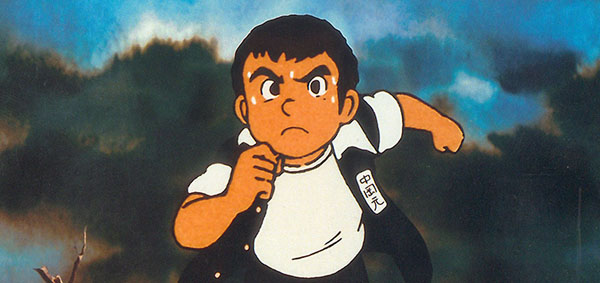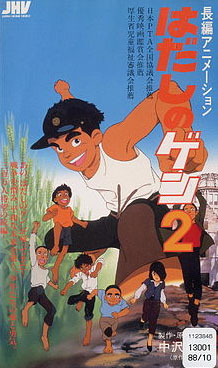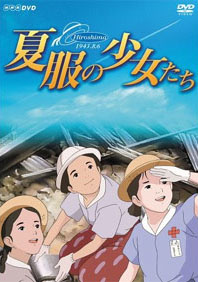
Ever since Japan’s surrender at the end of World War II, the Japanese have been conflicted about the amount of blame they bear for the war. The Japanese military, of course; nobody has anything good to say about the military-controlled government that got them into a losing war. But the people?
Starting in 1983, there have been several animated accounts of the horrific events of 1945, from the privations of the civilians who were literally starving, to the American military’s fire-bombing of several cities, culminating in the nuclear bombings of Hiroshima and Nagasaki. The stories are all told from the viewpoint of helpless civilians, usually children. From 1988 to 1991, there was an annual summer movie, directed by Seiji Arihara and animated by Mushi Productions for release through the Nikkatsu theater chain as a Nikkatsu Children’s Movie. The genre has slowed since then, but not died out.
Here is a list of them.
Barefoot Gen. Hadashi no Gen. 85 minutes, theatrically released July 21, 1983, directed by Mori Masaki and animated by Gen Productions and Studio Madhouse. This is the thinly-fictionalized autobiography of producer Keiji Nakazawa (1939-2012), a cartoonist who, as a six-year-old boy, lived through the atomic bombing of Hiroshima, witnessing his father and younger brother dying, crying for help, in the flaming rubble of their home. Nakazawa spent his life telling his wartime experiences through manga and animation. Nakazawa focused less blame on the American military for the bomb than on the Japanese military who started the war, and on the civilians who ignored his calls for help for himself, his badly-injured mother, and his dying little sister, shrugging him off with the excuse that “we’ve got troubles of our own.”
 Barefoot Gen 2. Hadashi no Gen 2. 86 minutes, theatrically released June 14, 1986, directed by Mori Masaki, animated by Gen Productions and Studio Madhouse. The continuation of Gen’s/Keiji Nakazawa’s story, adapted from volume 2 of his manga, Barefoot Gen: Out of the Ashes, set in 1948. Life is more positive, thanks to massive food donations by the American occupation forces (whom Gen hates), but Hiroshima is only beginning to rebuild and Gen and his mother have a very difficult time. Gen begins to mix his hard life with the play of a normal nine-year-old. But the first long-term effect of the bomb’s radiation on the survivors are seen, including Gen’s mother’s impending death from cancer.
Barefoot Gen 2. Hadashi no Gen 2. 86 minutes, theatrically released June 14, 1986, directed by Mori Masaki, animated by Gen Productions and Studio Madhouse. The continuation of Gen’s/Keiji Nakazawa’s story, adapted from volume 2 of his manga, Barefoot Gen: Out of the Ashes, set in 1948. Life is more positive, thanks to massive food donations by the American occupation forces (whom Gen hates), but Hiroshima is only beginning to rebuild and Gen and his mother have a very difficult time. Gen begins to mix his hard life with the play of a normal nine-year-old. But the first long-term effect of the bomb’s radiation on the survivors are seen, including Gen’s mother’s impending death from cancer.
The two Barefoot Gen movies were basically work-for-hire productions by Studio Madhouse for Gen Productions, Nakazawa’s company that was mostly funded by donations from anti-war activists. In addition to the two Gen movies, Nakazawa and Gen Productions made Summer With Kuro (Kuro ga ita natsu), a 67 minute theatrical feature released June 4, 1990, directed by Takeshi Shirato and animated by RCC Chugaku Broadcasting. This is the fictional story of Kuro (Blackie), a cute kitten who lives through the nuclear destruction of Hiroshima.
Grave of the Fireflies. Hotaru no Haka, a 89-minute theatrical release on April 16, 1988, directed by Isao Takahata and animated by Studio Ghibli. The story, in a flashback after his death, of Seita, a fourteen-year-old boy. He and his little sister Setsuko survive the March 16-17, 1945 firebombing that destroys Kobe and kills their mother. Left orphaned, the two children slowly starve to death amidst the chaos of Japanese society in the last months of the war. Based on a semibiographical novel by Akiyuki Nosaka.
A commercial failure because it is so depressing (since it is narrated by a child’s ghost, the audience knows from the beginning that it will have an unhappy ending), Grave of the Fireflies received almost unanimous rave reviews from critics, in Japan upon its theatrical release and in America upon its video release. Roger Ebert praised it in 2000 as one of the most beautiful anti-war films ever made. “Grave of the Fireflies is an emotional experience so powerful that it forces a rethinking of animation. […] “Grave of the Fireflies” is a powerful dramatic film that happens to be animated, and I know what the critic Ernest Rister means when he compares it to “Schindler’s List” and says, “It is the most profoundly human animated film I’ve ever seen.”
 Girls in Summer Clothes. Natsufuku no Shojo-tachi. A 50-minute TV special (34 minutes plus commercials) broadcast August 7, 1988, the 43rd anniversary of the nuclear bomb blast, directed by Toshio Hirata and Yoshiyuki Momose and animated by Studio Madhouse. In April 1945, the second- and third-year students girls’ school in Hiroshima are drafted for war work, leaving the 220 first-year girls almost alone. They become close friends. One of them, Yoko Moriwaki, keeps a diary, and much of the anime is based on the diary entries. The diary ends abruptly on August 7, 1945. None of the girls survive the nuclear blast.
Girls in Summer Clothes. Natsufuku no Shojo-tachi. A 50-minute TV special (34 minutes plus commercials) broadcast August 7, 1988, the 43rd anniversary of the nuclear bomb blast, directed by Toshio Hirata and Yoshiyuki Momose and animated by Studio Madhouse. In April 1945, the second- and third-year students girls’ school in Hiroshima are drafted for war work, leaving the 220 first-year girls almost alone. They become close friends. One of them, Yoko Moriwaki, keeps a diary, and much of the anime is based on the diary entries. The diary ends abruptly on August 7, 1945. None of the girls survive the nuclear blast.
 Raining Fire. Hi no Ame ga Furu. 80 minutes, a theatrical feature released September 15, 1988, directed by Seiji Arihara and animated by Mushi Productions. An anime adaptation of a book containing eye-witness accounts of the fire-bombing of Fukuoka on June 19, 1945, presented as the observations of two children.
Raining Fire. Hi no Ame ga Furu. 80 minutes, a theatrical feature released September 15, 1988, directed by Seiji Arihara and animated by Mushi Productions. An anime adaptation of a book containing eye-witness accounts of the fire-bombing of Fukuoka on June 19, 1945, presented as the observations of two children.
Kayoko’s Diary. Ushiro no Shomen Daare (literally The Front of the Back.) 90-minutes, a theatrical feature released September 3, 1991, directed by Seiji Arihara and animated by Mushi Productions. Kayoko is a little girl just starting first grade in Tokyo in 1940. As the war continues and she grows older, she goes from “fun” patriotic efforts such as singing martial songs in school and donating her plastic dolly to make explosives, to growing desperate privation as all food and resources are sent to the military. She is sent to the countryside to escape the American bombing of her city. She can see the distant light of Tokyo until the night of March 10, 1945 when Tokyo is fire-bombed; after that the city is dark. When she returns as the war ends, her neighborhood has been leveled and her family is dead. Based on the autobiography of Kayoko Ebina.
 Rail of the Star. O-Hoshisama no Rail, 79 minutes, a TV movie broadcast July 10, 1993, directed by Satoru Namekawa and Toshio Hirata and animated by Studio Madhouse. The true story of Chitose (Chiko) Kobayashi, who grew up as a little girl in Japanese-occupied Pyongyang, Korea in the late 1930s and early 1940s. As she grew older, her family life deteriorated with Japan’s defeats in the war, and she realized the hatred of the Koreans to their Japanese masters. With Japan’s surrender in 1945, the Kobayashis are thrown out of their upper-class home by the Koreans (it had been seized from a Korean in the first place for Japanese settlers to live in). When it is announced that Pyongyang will fall into the U.S.S.R. occupation zone, Chiko’s father decides to take the family on a risky migration by foot to U.S.-occupied South Korea, following the North Star by night. (Yes, everyone knows that “The Starlight Railway” would be a better translation, but the Japanese rights-holder insisted upon a more-or-less literal translation. A literal translation would be “Divine Star of Rail”.)
Rail of the Star. O-Hoshisama no Rail, 79 minutes, a TV movie broadcast July 10, 1993, directed by Satoru Namekawa and Toshio Hirata and animated by Studio Madhouse. The true story of Chitose (Chiko) Kobayashi, who grew up as a little girl in Japanese-occupied Pyongyang, Korea in the late 1930s and early 1940s. As she grew older, her family life deteriorated with Japan’s defeats in the war, and she realized the hatred of the Koreans to their Japanese masters. With Japan’s surrender in 1945, the Kobayashis are thrown out of their upper-class home by the Koreans (it had been seized from a Korean in the first place for Japanese settlers to live in). When it is announced that Pyongyang will fall into the U.S.S.R. occupation zone, Chiko’s father decides to take the family on a risky migration by foot to U.S.-occupied South Korea, following the North Star by night. (Yes, everyone knows that “The Starlight Railway” would be a better translation, but the Japanese rights-holder insisted upon a more-or-less literal translation. A literal translation would be “Divine Star of Rail”.)
The Angelus Bells. Nagasaki 1945: Angelus no Kane. 80 minutes, a theatrical feature released September 9, 2005, directed by Seiji Arihara and animated by Mushi Productions. Idealistic young Dr. Akizuki is assigned to run a tuberculous hospital near a closed Christian theological seminary on the outskirts of Nagasaki. He and his devoted staff are overwhelmed with critically injured and dying patients after the second atomic bomb is dropped on August 9, 1945.
To close, it should be noted that the Japanese have produced two feature-length adaptations of The Diary of Anne Frank. Anne Frank’s book is actually titled “The Diary of a Young Girl”. (1) Anne no Nikki: Anne Frank Monogatori. The Diary of Anne Frank: Anne Frank’s Story. This was a two-hour TV special movie (1 hour and 25 minutes without commercials) on September 28, 1979, produced by Nippon Animation. (2) Anne no Nikki. A 102-minute theatrical feature by Studio Madhouse, released on August 19, 1995.
The 1979 semi-realistic TV movie, directed by Eiji Okabe, features naturalistic designs for the actual story, which is broken up by Anne’s Picasso-like surrealistic dream sequences. The more realistic, better animated but less imaginative 1995 theatrical feature, directed by Akinori Nagaoka, is mostly notable for its music by Michael Nyman. The soundtrack album contains 19 tracks.
I assume that nobody here needs a plot synopsis of The Diary of Anne Frank. This to some extent balanced all of the animation showing Japanese children as the innocent victims of war.
Next week: I’m back to discussing non-Japanese animation.


 Fred Patten (1940-2018) was an internationally respected comics and animation historian. He has written about anime or comic books for publications ranging from Animation Magazine and Alter Ego to Starlog. He was a contributor to The Animated Movie Guide (2005), and is author of Watching Anime, Reading Manga (2004, Stone Bridge Press), a collection of his best essays, and Funny Animals and More (2014, Theme Park Press), based upon his early columns here on Cartoon Research. He passed away on November 12th, 2018.
Fred Patten (1940-2018) was an internationally respected comics and animation historian. He has written about anime or comic books for publications ranging from Animation Magazine and Alter Ego to Starlog. He was a contributor to The Animated Movie Guide (2005), and is author of Watching Anime, Reading Manga (2004, Stone Bridge Press), a collection of his best essays, and Funny Animals and More (2014, Theme Park Press), based upon his early columns here on Cartoon Research. He passed away on November 12th, 2018.





































I’ve read the manga on which Barefoot Gen was based, but I’m terrified of watching the anime version because Grave of the Fireflies absolutely devastated me emotionally. It’s a movie I recommend very highly but will never, ever watch again. The most heartbreaking moments of Full Metal Alchemist and The Plague Dogs are walks in the park by comparison (and they’re on my can’t-watch list too).
Still in all fairness, unlike Seita in Grave of the Fireflies, Gen does come out on top in the end. There’s still a theme of never giving up in the story that the viewer has to keep in mind while reading it.
Barefoot Gen and Grave of the Fireflies are two very different movies. The latter is a soul-wrenching tearjerker, and the former is a good drama that balances humour, horror and drama in a highly entertaining and informative way. There’s a scene in the last half of the movie of two boys continuously slapping an ungrateful old man. It’s hilarious!
Not every war movie has to be depressing.
Assuming this article was somewhat inspired by the release of The Wind Rises, am I right? What did you think of it (I loved it)?
Nope. I have not seen “The Wind Rises” yet, and probably will not until it is released on DVD. ASIFA-Hollywood and Disney are holding some special screenings around Los Angeles for Annie Award consideration, and to qualify for the 2013 Oscars, but all are that theaters or times that I cannot get to.
You need to add “The Wind Rises” to this list, even though technically most of it takes place in the ’20s and ’30s. It is a very strong statement of committed pacifism but also a paen to the joy of flight and the beauty of flying machines. Miyazaki-sensei’s farewell film is beautifully done, and a great statement of his opposition to Japan being remilitarized.
It’s a bit boggling to reflect that much of this was at least nominally children’s entertainment. Imagine kids’-eye views of war and death — American-made — on Cartoon Network.
Were Japanese live-action filmmakers looking at this moment in history, or was it mainly the animators?
I do not really know, but I would guess the animators. For one thing, I think that only “Grave of the Fireflies” was initiated by its animators. All of the others were either works-for-hire sponsored by anti-war groups, or were made for an intelligentsia audience rather than being commercial projects. The Anne Frank TV special was made for broadcast on NHK, the government channel that regularly shows animated adaptations of famous literature. Also, this type of movie usually emphasizes suffering children, and animated cartoons seem more naturally associated with children.
I think animation is a proven medium for stories like this where live-action, it might be harder to convey serious acting such as with children in this manner. I recall “Grave of The Fireflies” did receive a live-action made-for-TV film that focused more on the aunt than the children, but think Takahata’s take on the story best reflected the tragedy that unfolds with the two central figures themselves.
Of course with Barefoot Gen, we have a semi-biographical tale told with a more cartoonier appearance for our figures that might evoke the familiar look people were seeing in manga of the day. Sometimes you could create interesting contrasts between the realism and graphical abstractions that the comic book or animation medium could occupy and be able to convey those stories well as long as the audience isn’t left out in the dark if they had to keep fussing over the details (since that often is a hurdle one must get past if they’re going to find something to take away from the experience).
Speaking of anime/WWII, another film I could suggest, though not really ‘anime’ and very short, is Renzo and Sayoko Kinoshita’s artistic approach to the Hiroshima bombing with their 1978 effort “Picadon”.
http://nishikataeiga.blogspot.com/2010/01/pica-don-1978.html
https://www.youtube.com/watch?v=scoV4whiCjo
The only one of these films I have seen is Grave of the Fireflies. It is a powerful film. In just about every film about World War 2, scenes of bombing are always shown from the point of view of the bomber. You see the bomb bay doors open and the bombs recede into the background and when they strike the ground, they open like beautiful flowers and you are so removed from the horror, that you admire the beauty.
In Grave of the Firefiles, you see the bombing from ground level, from the victim’s point of view. After a montage of the boy and girl running through terrifying devastation amidst burning people and chaos, it finally cuts to the traditional shot from the bomb bay doors and you are thinking, “You bastards!” It is the best anti war movie I ever saw.
I saw “Railway to the Star” in classroom years back, dubbed in English. One of the most intense piece of animation I ever saw.
Or so I thought. Then we later saw “Grave of the Fireflies”. Still spooks me to this day.
Giovanni’s Island should be added to this list too. It was released in 2014. It’s about the Russian occupation of the northern islands of Japan after the war, also told from the perspective of a child. The film starts with the main character returning to his Russian settled island 50 years later with his teacher to attend his primary school graduation.